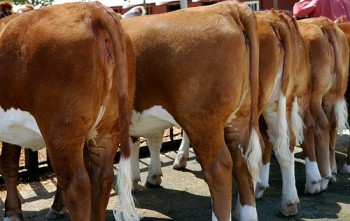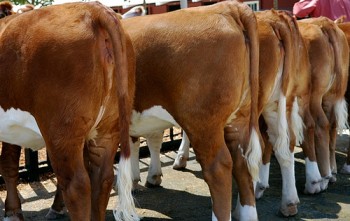
Like many others in the climate movement, I have been waiting for weeks (well, years actually) for broad and sweeping climate change legislation. Back in January the economy captured Congressional attention and I knew global warming legislation would simply have to wait. Finally, yesterday, Representatives Markey and Waxman introduced their “American Clean Energy and Security Act of 2009”, a wide-reaching cap and trade initiative with more ambitious emission reductions (83% below 2005 levels by 2050) than President Obama had even advocated for. For that, and for a variety of other progressive initiatives including those for energy efficiency, green jobs, and climate change adaptation, the bill is commendable. But, Markey and Waxman had one large oversight in drafting the bill — they cut the crap, literally.
Buried about halfway through the monster 648 page draft is a crucial statement: “controlling emissions in small as well as large amounts is essential to prevent, slow the pace of, reduce the threats from, and mitigate global warming and its adverse effects.” I couldn’t agree more, which is why I was shocked to see that the bill fails to address greenhouse gas emissions from agriculture, factory farms, and animal manure whatsoever — and even goes the extra mile to specifically exempt the entire sector from any type of regulation.
Under the proposed legislation the agricultural sector is explicitly exempted under the definition of “capped sector”. Since capped sectors will be those that will be required to reduce emissions under the compliance portion of the bill, this means that the entire sector has been given a free pass from any type of emissions reductions. Unfortunately, the bill goes one step farther and makes additional exemptions under the uncapped sector section as well, where sources of emissions will be listed and then, in several years, formed into standards and promulgated into regulation. The bill specifically designates that sources of methane emissions be a separate category of this uncapped sources list, but then explicitly exempts enteric fermentation (i.e. livestock burps and farts) from being included on this list. Enteric fermentation is literally the largest source of methane emissions in the entire country. This means that not only are livestock left out of this bill, but the largest source of methane emissions would be left out of all future regulations for methane emissions in the United States from the uncapped sector.
So, big deal right? Who really cares about cow farts anyway when we have coal fired power plants to deal with? I respectfully disagree. Energy and climate policy that doesn’t consider the impact of our food and agricultural systems on greenhouse gas emissions is missing a big chunk of the problem. Collectively, our entire food system and associated emissions may be contributing up to 1/3 of global greenhouse emissions by some scientific accounts. Domestically, the agricultural sector (which doesn’t include things like food processing, packaging and transportation) accounts for nearly 2/3 of all nitrous oxide emissions, which by the Markey and Waxman bill is 298 times as potent as CO2. About 1/3 of all methane emissions (which is 25 times as potent as CO2) in the United States are solely from enteric fermentation and manure management.
To put it in perspective, according to the US EPA 2009 Draft GHG Inventory the agriculture sector produces 413 Tg of carbon dioxide equivalents a year, and the entire Industrial Processes sector produces 328 Tg of carbon dioxide equivalents. Let’s couple that 328 Tg with the methane emissions produced by coal mining and petroleum systems (collectively about 86 Tg of carbon dioxide equivalents) and then we’re talking about what the Markey and Waxman bill exempts. If you think agricultural emissions don’t matter, ask yourself if you would feel differently if the bill completely exempted the entire industrial processes sector, and certain emissions from coal mining and petroleum.
What is so interesting about the bill is the lengths it goes to make sure that agriculture is uniquely left out of the regulations. For example, agriculture does play a prominent role in the bill as a source of potential renewable electricity credits with manure digesters and crop biofuels. But while ethanol production plants are explicitly included as an industrial sector that will be regulated under the cap, livestock and manure management are not. So, in essence, biofuels may be eligible for offset credits, but they’ll also be responsible for the emissions they may be producing as well. But, not so for livestock manure, which will be eligible for offsets, but not actually have to do anything to reduce its emissions in the first place. It should also be noted that in the forthcoming EPA’s proposed mandatory GHG reporting rule, manure management is specifically identified as a source of emissions that would be required to report their emissions. This means the problem is not that we can’t measure agriculture and livestock emissions- we obviously can if we can give potential offset credits to the sector and the EPA is going to require that they report emissions.
To be more hopeful, I will say that the bill does have excellent standards in place to regulate other food system greenhouse gas emissions. The bill would require emissions standards for heavy duty nonroad equipment including tractors, combines and other heavy agricultural machinery. As well, nearly every food processing industry would be included under the cap if they produced above the threshold of 25,000 tons of CO2 equivalents a year. This would include everything from animal slaughter facilities to wet corn milling and snack food processing plants. In the Green Jobs section, the bill specifically notes the importance of establishing education and training programs for sustainable agriculture and farming and sustainable culinary practices. And, the bill includes fantastic initiatives to establish a National Climate Change Adaptation Council, which would examine the broad impacts of climate change on a variety of areas including agriculture.
But, all of those things are hard to appreciate when the larger agricultural and livestock sector is completely exempted from reducing their emissions. Agriculture is unique in the climate change debate because it is both a source of emissions and a potential for mitigation. We clearly can not forget the role that sustainable agriculture can play in mitigating greenhouse gas emissions, and the ways that farmers can and should be a part of our climate change initiatives and policies. But, rewarding the beneficial part of the system without acknowledging the downside to our industrial agricultural practices is only rewarding the largest and most polluting parts of our food system. A cap on agriculture in this bill would not hurt small-scale family farmers, which would be nowhere near triggering the threshold for regulation. Instead, it would target the biggest sources of agricultural emissions from large-scale corporate factory farms that are the largest emitters in the sector. And, just like big coal needs to clean up its act, so does big ag. As we move forward with the draft discussion of the bill I hope that Congress can recognize the importance of regulating agriculture in our climate change legislation just as any other sector should and will be regulated.



